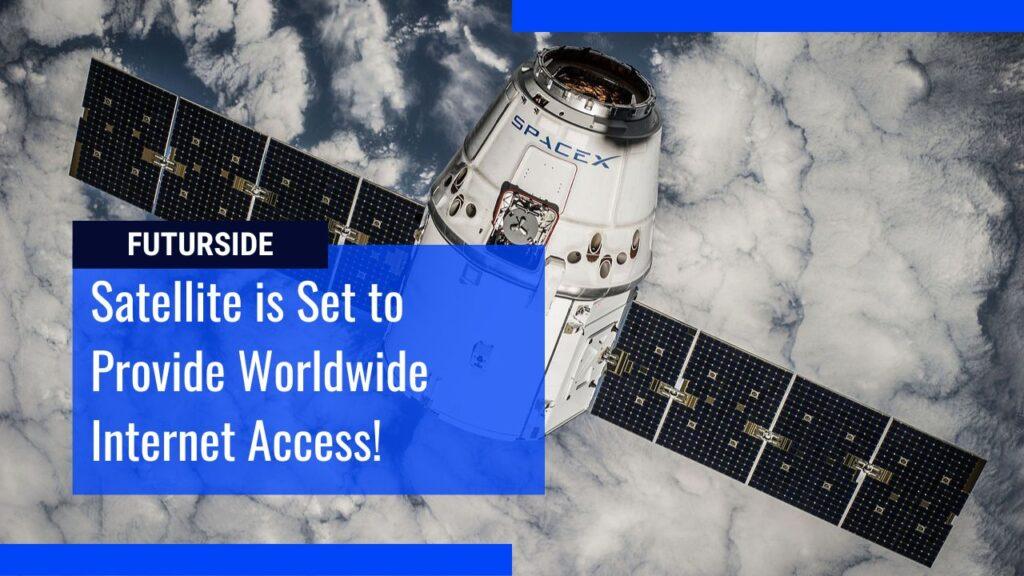Imagine having access to connectivity almost anywhere around the world. We’ve all become accustomed to having reliable internet access. Nowadays we all rely on the internet for at least one daily task. We access it through devices such as smartphones, computers and tablets and more recently wearables and the Internet of Things.
And for these devices to access the internet, a lot of data is needed and is generated as well. Information is constantly traveling in a loop from your device to the network operation center through underground cables. Connectivity has become so important that in 2016 the UN declared that internet access is a human right.
However, according to the world economic forum, almost half the world’s population doesn’t have access to connectivity. This is mostly due to people living in rural areas who don’t have access to cables that provide reliable broadband. That is why satellites could be a game-changer in these regions.
Satellite internet technology makes high-speed connectivity available in remote or rural areas from the sky. Instead of using underground cords and cables, low-orbiting satellites bring the connection to remote communities. The most famous satellite internet provider is SpaceX’s Starlink.
Even though not fully completed, Starlink’s network of satellites would provide connectivity to areas where installing ground and underground infrastructure isn’t feasible due to geographic, economic or political boundaries. This could even mean fast and reliable internet for ships, airplanes and the arctic circle.
The company CEO Elon Musk is hoping to send 42,000 of these satellites into space over the next decades. So what are the hypes around satellite internet?

Contents
What is Satellite Internet?
As the name suggests, satellite internet is a form of wireless web service that relies on geostationary satellites to relay signals. The dish receives the signal and sends it back to the provider’s central hub, which is then connected to the traditional wired internet. It’s the same system that satellite TV uses to provide video streams.
Satellite internet works by transmitting radio waves. The signals are transmitted by the Service Provider through a dish or modem, which then sends them to a satellite that transmits the data back to earth. Once the data is sent, the dish or device will receive the data and pass it along to the next user. This cycle continues indefinitely.
Regardless of where you are, you’ll be able to connect to the internet with satellite-connected devices. Orbital connectivity is useful if you don’t have other options for web access. It can be an excellent option for those living in rural areas or remote regions where land-based service is unavailable.
Starlink is an ambitious space-age internet solution that promises to make it possible for even the most remote places to get high-speed web access. SpaceX, a private aerospace company has plans to launch a constellation of small satellites into low-Earth orbit, where they will work with ground-based receivers to provide connectivity.
This innovative concept could change the way people connect to the web. While Starlink is still in its beta stage, it does have potential as a reliable alternative to traditional broadband transmission. The launch of the first batch of satellites by SpaceX a few years ago signaled the beginning of a new era of personal connectivity.
Outer space internet has become so popular that many tech giants have gotten into the game. Google, Microsoft and Facebook are all in on the satellite internet space. And now Jeff Bezos is also in the business. While these players have yet to launch their own satellite internet service, there’s no shortage of companies rushing in.
What is SpaceX Starlink?
There are many reasons to get satellite Internet. Most of us can get fast wireless connectivity from our homes but it may be difficult if we live in an area where we cannot get reliable service. Luckily, there are companies such as SpaceX working on satellite Internet services.

The technology will be able to bring broadband connectivity to remote areas without the use of wires. Satellite internet transmission can reach places that cables can’t. However, due to long-distance travel, its data capacity is limited which in turn limits connection speeds. The signal has to travel a long way which affects its latency.
This is where Starlink can solve this issue. It is a globe-encircling network of internet-beaming satellites that get you online no matter where you are in the world. While the service is not yet available to everyone, it can still be a lifesaver in disaster zones. SpaceX’s Starlink satellite internet system is a breakthrough in the space industry.
The launch of this service has sparked high hopes among the tech community. Till now Elon Musk’s company has launched a couple thousand of its satellites out in the space, but it still has a long way to go before the service can become widely available to all consumers.
As of May 2022, SpaceX has already launched 2200 satellites into orbit and has planned to release a total of 12,000 over the next five years with half of them by the end of 2024. Elon Musk wants to add a total of 42,000 satellites circling Earth. All of these orbiting objects will also be from 200 to 400 miles above the planet in low-Earth orbit.
Every satellite is connected with several others via laser beams, creating something like the network’s backbone. And to bring this internet to the user, a small antenna is needed. The antenna aims its beam at the closest overhead satellite to maintain a connection. In this way, Starlink can provides high-speed low-latency broadband internet to rural communities.
Why satellite internet is important?
There are still millions of people who don’t have access to high-speed wired connectivity. Additionally, people rely on traditional satellite connectivity for a variety of purposes including work, entertainment, and education. But while it may be adequate for some users, it has its problems, including speed issues, latency, and service interruptions.
This is why the technology of Starlink is all the more valuable. Rural areas that have limited access to terrestrial broadband can have a viable alternative with Starlink. A teleporter, Network Operation Center (NOC), terminal and satellite are the components of this web network. These components work together to deliver high-speed web access with minimal downtime.
The service is easy to set up and can be installed in a matter of minutes. It is becoming increasingly popular among users as it can be installed in less than ten minutes and requires fewer complicated technical installations compared to fiber-optic setups. Many users believe that this breakthrough is a game-changer for mobile users.
These services typically require you to buy a satellite terminal and follow a web of satellites to receive service. The terminal will track the web of orbiting devices to maintain a connection. As long as the terminal is pointing at the sky, it should work. The service works similarly to satellite TV. It uses a satellite to transmit the web signal, which is then reflected back from the orbiting devices.
Some users believe it’s better than the traditional connection and are eager to get on with their work. With satellite web, you’ll be able to stay connected from anywhere even in remote locations. And the speed will be faster than the traditional connection, offering up to 300 Mbps.
Jio Platforms, owned by the Indian Billionaire Mukesh Ambani, recently signed a joint venture with the European satellite-based broadband service company SES. Several other tech giants are also planning to send thousands of satellites into orbit to provide broadband services to their customers.

These services will be great for rural and remote areas where traditional internet service providers simply cannot justify building infrastructure. Alternatively, they can provide fast and reliable connections to people in large cities. While satellite connection is quite expensive, it’s an important part of modern society.
It is also available at higher speeds than dial-up connection which increases productivity and reduces downtime. For many people, the outer space internet is a good choice when traditional service is unreliable and expensive. And with Starlinks positioned at a lower orbit allowing for lower latency, remote areas will have more reliable connections.
One of the biggest advantages of satellite internet is its availability. It allows people to access the web virtually anywhere in the world. As a result, it’s an excellent choice for rural or remote areas where traditional connections are unavailable. It’s also the fastest way to connect over water. With satellite technology, you can connect to the web from ships and aircraft.
Although satellite connectivity is not cheap, it’s often the only option for some areas. For example, if you live in the middle of the desert, a satellite may be your best option. It can also cover large areas with poor mobile data coverage. However, with more orbiting projects coming online, satellite internet prices may fall.
An advantage of Starlink is that it can provide much lower latency compared to other companies. Latency is the time it takes to send data from one point to the next. When satellites are far from earth, the latency is high resulting in poor performance. Starlink is over 60 times closer to earth compared to traditional satellites resulting in lower latency and better performance.
Starlink’s speeds are expected from 50 megabits per second to 150 megabits per second and latency from 20 milliseconds to 40 milliseconds in most locations. This is impressive given the internet data traveling to and from space. This could be life-changing for those in underdeveloped areas of the world.
Future of Satellite Internet
The future of satellite-based broadband depends on having the greatest amount of bandwidth available in space. While individual satellites can provide limited bandwidth, larger constellations are expected to make it possible to offer high-speed access to a greater number of users.
The benefits of satellite internet are obvious, but despite these benefits, many companies have had trouble implementing the technology. Alphabet, for instance, is continuing the Loon project, which began as a Google experiment ten years ago, using high-altitude balloons to beam internet access to rural areas.
This new technology was recently deployed to restore service to the millions of people living in Kenya following Hurricane Maria. Viasat has plans to launch its new Viasat 3 satellite next year. This will dramatically improve Viasat’s network. While some users are skeptical about the new technology, most would agree that it will improve the way people live.
While it may not be necessary for people in densely populated areas to get blazing-fast speeds, some people will find it indispensable. For example, 55% of non-satellite Internet users said they would switch to Starlink if it offered better service. While these statistics are interesting, the reality is that fewer people in densely populated areas are using satellite web, and most of these people have a single provider.
The latest Starlink expansion brings connectivity into the mainstream and a wider audience in remote areas. Starlink is the first service provider to offer service in the northernmost states of the US, Canada and Australia. Its new satellites are expected to provide connection speeds of 150 Mbps and increased data capacity.
Starlink is the most advanced satellite internet service currently available. However, because it uses low-Earth orbit technology, its service is still subject to connection issues and service interruptions. For this reason, Starlink is targeting businesses and high-demand users depending on the area.
If you live in a big city, most of your data will likely still come from underground cables but if you like fast connection in places you can’t gain access to it, satellite connectivity can be a solution to satisfy our ever-growing hunger for data. This solution to internet accessibility can change the way we connect around the world.

0 Comments